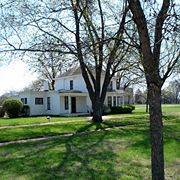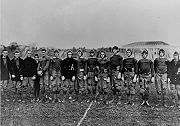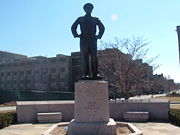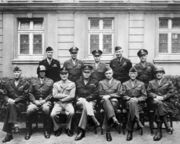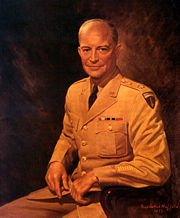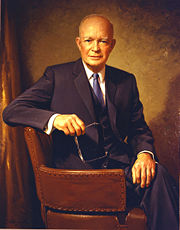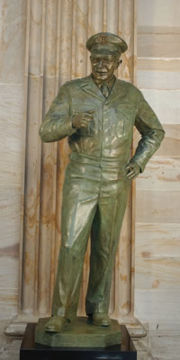Dwight D. Eisenhower
2008/9 Schools Wikipedia Selection. Related subjects: USA Presidents
|
Dwight David Eisenhower
|
|
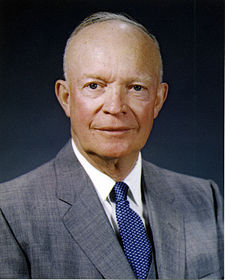 |
|
|
|
|
|---|---|
| In office January 20, 1953 – January 20, 1961 |
|
| Vice President | Richard Nixon |
| Preceded by | Harry S. Truman |
| Succeeded by | John F. Kennedy |
|
1st Supreme Allied Commander Europe
|
|
| In office April 2, 1951 – May 30, 1952 |
|
| Succeeded by | Gen. Matthew Ridgway |
|
|
|
| Born | October 14, 1890 Denison, Texas, United States |
| Died | March 28, 1969 (aged 78) Washington, D.C., United States |
| Nationality | United States |
| Political party | Republican |
| Spouse | Mamie Doud Eisenhower |
| Alma mater | U.S. Military Academy West Point, New York, United States |
| Occupation | Soldier |
| Religion | Presbyterian |
| Signature | |
| Military service | |
| Service/branch | United States Army |
| Years of service | 1915–1953, 1961–1969 |
| Rank | General of the Army |
| Commands | Europe |
| Battles/wars | World War II |
| Awards | Army Distinguished Service Medal with four oak leaf clusters, Legion of Merit, Order of the Bath, Order of Merit, Legion of Honour (partial list) |
Dwight David Eisenhower ( October 14, 1890 – March 28, 1969), nicknamed "Ike", was a General of the Army (five star general) in the United States Army and U.S. politician, who served as the thirty-fourth President of the United States (1953–1961). During the Second World War, he served as Supreme Commander of the Allied forces in Europe, with responsibility for planning and supervising the successful invasion of France and Germany in 1944–45. In 1951, he became the first supreme commander of NATO.
As President, he oversaw the cease-fire of the Korean War, kept up the pressure on the Soviet Union during the Cold War, made nuclear weapons a higher defense priority, launched the Space Race, enlarged the Social Security program, and began the Interstate Highway System.
Early life and family
Eisenhower was born David Dwight Eisenhower in Denison, Texas. He was the first U.S. President born in Texas. Eisenhower was the third of seven sons born to David Jacob Eisenhower and Ida Elizabeth Stover. He was named David Dwight and was called Dwight. Later, the order of his given names was switched (according to the staff at the Eisenhower Library and Museum, the name switch occurred upon Eisenhower's matriculation at West Point).
His early ancestor Hans Nicolas Eisenhauer and his family emigrated from Karlsbrunn ( Saarland), Germany to Lancaster, Pennsylvania in 1741. Descendants made their way west. Eisenhower's family settled in Abilene, Kansas in 1892. David Eisenhower was a college-educated engineer. Eisenhower graduated from Abilene High School in 1909.
Eisenhower married Mamie Geneva Doud (1896–1979) of Denver, Colorado on July 1, 1916. The couple had two sons. Doud Dwight Eisenhower was born September 24, 1917, and was nicknamed "Icky" by his parents, but died of scarlet fever on January 2, 1921, at the age of three.
John Sheldon David Doud Eisenhower was born the following year on August 3, 1922; John grew up to serve in the United States Army (retiring as a brigadier general from the Army reserve), became an author, and served as U.S. Ambassador to Belgium from 1969 to 1971. John, coincidentally, graduated from West Point on D-Day, June 6, 1944, and was married to Barbara Jean Thompson in a June wedding in 1947. John and Barbara had four children: Dwight David II, Barbara Ann, Susan Elaine and Mary Jean.
John's son, David, after whom Camp David is named, married Richard Nixon's daughter Julie in 1968.
Religion
David Jacob Eisenhower's paternal ancestor immigrated to the United States in 1741 when Hans Nicholas Eisenhauer emigrated from Odenwald, Germany. He was probably of Lutheran or Reformed Protestant practice. Eisenhower's mother, Ida E. Eisenhower, previously a member of the River Brethren sect of the Mennonites, joined the Watch Tower Bible and Tract Society (now more commonly known as Jehovah's Witnesses) between 1895 and 1900, when Eisenhower was a child. The Eisenhower home served as the local meeting hall from 1896 to 1915.
When Eisenhower joined the United States Military Academy at West Point, New York in 1911, his ties to Jehovah’s Witnesses were weakened due to the group's anti- militarist stance. By 1915, his parents' home no longer served as the meeting hall. All the men in the household abandoned the Witnesses as adults. Some hid their previous affiliation. At his death in 1942, Eisenhower's father was given funeral rites as though he remained a Jehovah's Witness. Eisenhower's mother continued as an active Jehovah's Witness until her death. Despite their differences in religious beliefs, Eisenhower enjoyed a close relationship with his mother.
Eisenhower was baptized, confirmed, and became a communicant in the Presbyterian Church in a single ceremony on February 1, 1953, just 12 days after his first inauguration. He is the only president known to have undertaken these rites while in office. Eisenhower was instrumental in the addition of the words "under God" to the Pledge of Allegiance in 1954, and the 1956 adoption of " In God We Trust" as the motto of the US, and its 1957 introduction on paper currency. In his retirement years, he was a member of the Gettysburg Presbyterian Church. The chapel at his presidential library is intentionally inter-denominational.
He questioned Billy Graham over how people can be certain they are going to Heaven after death.
Eisenhower was sworn into office with his personal West Point Bible, open to Psalm 33:12, at both his 1953 and 1957 inaugural ceremonies. Additionally for 1953, he included the Bible that George Washington had used in 1789 (belonging to St. John's Masonic Lodge No. 1), opened to II Chronicles 7:14.
Education
Dwight D. Eisenhower (and his six brothers) attended Abilene High School in Abilene, Kansas; Dwight graduated with the class of 1909. He then took a job as a night foreman at the Belle Springs Creamery.
After Dwight worked for two years to support his brother Edgar's college education, a friend urged him to apply to the Naval Academy. Though Eisenhower passed the entrance exam, he was beyond the age of eligibility for admission to the Naval Academy.
Kansas Senator Joseph L. Bristow recommended Dwight for an appointment to the Military Academy in 1911, which he received. Eisenhower graduated in the upper half of the class of 1915.
Athletic career
Eisenhower long had aspirations of being a professional baseball player. He is quoted saying that
"When I was a small boy in Kansas, a friend of mine and I went fishing and as we sat there in the warmth of the summer afternoon on a river bank, we talked about what we wanted to do when we grew up. I told him that I wanted to be a real major league baseball player, a genuine professional like Honus Wagner. My friend said that he'd like to be President of the United States. Neither of us got our wish."
At West Point, Eisenhower tried out for the baseball team but did not make it. He would later be quoted as saying that "Not making the baseball team at West Point was one of the greatest disappointments of my life, maybe my greatest."
But Eisenhower did make the football team. He started as a varsity running back and linebacker in 1912. In a bit of a fabled match-up, he even tackled the legendary Jim Thorpe in a 1912 game. The next week however, Eisenhower would hurt his knee after being tackled around the ankles, which he would soon worsen and permanently damage on horseback and in the boxing ring. He would later serve as junior varsity football coach and yell leader.
Controversy persists over whether Eisenhower played minor league (semi-professional) baseball for Junction City in the Central Kansas League the year before he attended West Point and played amateur football there.
In 1916, while stationed at Fort Sam Houston, Eisenhower was football coach for St. Louis College, now St. Mary's University.
Early military career
Eisenhower enrolled at the United States Military Academy at West Point in June 1911. His parents were against militarism, but did not object to his entering West Point because they supported his education. Eisenhower was a strong athlete and enjoyed notable successes in his competitive endeavors. In 1912, a spectacular Eisenhower touchdown won praise from the sports reporter of the New York Herald, and he even managed, with the help of a linebacker teammate, to tackle the legendary Jim Thorpe. In the very next week, however, his promising sports career ended when he incurred a severe knee injury.
Eisenhower graduated in 1915. He served with the infantry until 1918 at various camps in Texas and Georgia. During World War I, Eisenhower became the #3 leader of the new tank corps and rose to temporary ( Bvt.) Lieutenant Colonel in the National Army. He spent the war training tank crews in Pennsylvania and never saw combat. After the war, Eisenhower reverted to his regular rank of captain (and was promoted to major a few days later) before assuming duties at Camp Meade, Maryland, where he remained until 1922. His interest in tank warfare was strengthened by many conversations with George S. Patton and other senior tank leaders; however their ideas on tank warfare were strongly discouraged by superiors.
Eisenhower became executive officer to General Fox Conner in the Panama Canal Zone, where he served until 1924. Under Conner's tutelage, he studied military history and theory (including Karl von Clausewitz's On War), and later cited Conner's enormous influence on his military thinking. In 1925–26, he attended the Command and General Staff College at Fort Leavenworth, Kansas, and then served as a battalion commander at Fort Benning, Georgia until 1927.
During the late 1920s and early 1930s Eisenhower's career in the peacetime Army stagnated; many of his friends resigned for high paying business jobs. He was assigned to the American Battle Monuments Commission, directed by General John J. Pershing, then to the Army War College, and then served as executive officer to General George V. Mosely, Assistant Secretary of War, from 1929 to 1933. He then served as chief military aide to General Douglas MacArthur, Army Chief of Staff, until 1935, when he accompanied MacArthur to the Philippines, where he served as assistant military adviser to the Philippine government. It is sometimes said that this assignment provided valuable preparation for handling the challenging personalities of Winston Churchill, George S. Patton and Bernard Law Montgomery during World War II. Eisenhower was promoted to lieutenant colonel (in a non-brevet status) in 1936 after sixteen years as a major. He also learned to fly, although he was never rated as a military pilot. He made a solo flight over the Philippines in 1937.
Eisenhower returned to the U.S. in 1939 and held a series of staff positions in Washington, D.C., California and Texas. In June 1941, he was appointed Chief of Staff to General Walter Krueger, Commander of the 3rd Army, at Fort Sam Houston in San Antonio, Texas. He was promoted to brigadier general in September 1941. Although his administrative abilities had been noticed, on the eve of the U.S. entry into World War II he had never held an active command and was far from being considered as a potential commander of major operations.
World War II
After the Japanese attack on Pearl Harbour, Eisenhower was assigned to the General Staff in Washington, where he served until June 1942 with responsibility for creating the major war plans to defeat Japan and Germany. He was appointed Deputy Chief in charge of Pacific Defenses under the Chief of War Plans Division, General Leonard T. Gerow, and then succeeded Gerow as Chief of the War Plans Division. Then he was appointed Assistant Chief of Staff in charge of Operations Division under Chief of Staff General George C. Marshall. It was his close association with Marshall that finally brought Eisenhower to senior command positions. Marshall recognized his great organizational and administrative abilities.
In 1942, Eisenhower was appointed Commanding General, European Theatre of Operations (ETOUSA) and was based in London. In November, he was also appointed Supreme Commander Allied (Expeditionary) Force of the North African Theatre of Operations (NATOUSA) through the new operational Headquarters A(E)FHQ. The word "expeditionary" was dropped soon after his appointment for security reasons. In February 1943, his authority was extended as commander of AFHQ across the Mediterranean basin to include the British 8th Army, commanded by General Bernard Law Montgomery. The 8th Army had advanced across the Western Desert from the east and was ready for the start of the Tunisia Campaign. Eisenhower gained his fourth star and gave up command of ETOUSA to be commander of NATOUSA. After the capitulation of Axis forces in North Africa, Eisenhower remained in command of the renamed Mediterranean Theatre of Operations (MTO), keeping the operational title and continued in command of NATOUSA redesignated MTOUSA. In this position he oversaw the invasion of Sicily and the invasion of the Italian mainland.
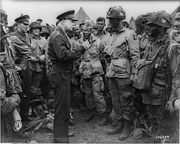
In December 1943, it was announced that Eisenhower would be Supreme Allied Commander in Europe. In January 1944, he resumed command of ETOUSA and the following month was officially designated as the Supreme Allied Commander of the Allied Expeditionary Force (SHAEF), serving in a dual role until the end of hostilities in Europe in May 1945. In these positions he was charged with planning and carrying out the Allied assault on the coast of Normandy in June 1944 under the code name Operation Overlord, the liberation of western Europe and the invasion of Germany. A month after the Normandy D-Day landings on June 6, 1944, the invasion of southern France took place, and control of the forces which took part in the southern invasion passed from the AFHQ to the SHAEF. From then until the end of the War in Europe on May 8, 1945, Eisenhower through SHAEF had supreme command of all operational Allied forces2, and through his command of ETOUSA, administrative command of all U.S. forces, on the Western Front north of the Alps.
As recognition of his senior position in the Allied command, on December 20, 1944, he was promoted to General of the Army equivalent to the rank of Field Marshal in most European armies. In this and the previous high commands he held, Eisenhower showed his great talents for leadership and diplomacy. Although he had never seen action himself, he won the respect of front-line commanders. He dealt skillfully with difficult subordinates such as Omar Bradley and Patton, and allies such as Winston Churchill, Field Marshal Bernard Montgomery and General Charles de Gaulle. He had fundamental disagreements with Churchill and Montgomery over questions of strategy, but these rarely upset his relationships with them. He negotiated with Soviet Marshal Zhukov, and such was the confidence that President Franklin D. Roosevelt had in him, he sometimes worked directly with Stalin, much to the chagrin of the British High Command who disliked being bypassed. During the advance towards Berlin, he was notified by General Bradley that Allied forces would suffer an estimated 100,000 casualties before taking the city. The Soviet Army sustained 80,000 casualties during the fighting in and around Berlin, the last large number of casualties suffered in the war against Nazism.
It was never certain that Operation Overlord would succeed. The seriousness surrounding the entire decision, including the timing and the location of the Normandy invasion, might be summarized by a second shorter speech that Eisenhower wrote in advance, in case he needed it. In it, he states he would take full responsibility for catastrophic failure, should that be the final result. Long after the successful landings on D-Day and the BBC broadcast of Eisenhower's brief speech concerning them, the never-used second speech was found in a shirt pocket by an aide. It read:
Our landings in the Cherbourg-Havre area have failed to gain a satisfactory foothold and I have withdrawn the troops. My decision to attack at this time and place was based on the best information available. The troops, the air and the Navy did all that bravery and devotion to duty could do. If any blame or fault attaches to the attempt, it is mine alone.
Aftermath of World War II
Following the German unconditional surrender on May 8, 1945, Eisenhower was appointed Military Governor of the U.S. Occupation Zone, based in Frankfurt am Main. Germany was divided into four Occupation Zones, one each for the U.S., Britain, France, and the Soviet Union. Upon full discovery of the death camps that were part of the Final Solution (Holocaust), he ordered camera crews to comprehensively document evidence of the atrocity for use in the war crimes tribunals. He made the decision to reclassify German prisoners of war (POWs) in U.S. custody as Disarmed Enemy Forces (DEFs), thus depriving them of the protection of the Geneva convention. As DEFs, their food rations could be lowered and they could be compelled to serve as unfree labor (see Eisenhower and German POWs). Eisenhower was an early supporter of the Morgenthau Plan to permanently remove Germany's industrial capacity to wage future wars. In November 1945 he approved the distribution of 1000 free copies of Morgenthau's book Germany is Our Problem, which promoted and described the plan in detail, to American military officials in occupied Germany. Historian Stephen Ambrose draws the conclusion that, despite Eisenhower's later claims the act was not an endorsement of the Morgenthau plan, Eisenhower both approved of the plan and had previously given Morgenthau at least some of his ideas about how Germany should be treated. He also incorporated officials from Morgenthau's Treasury into the army of occupation. These were commonly called "Morgenthau boys" for their zeal in interpreting the occupation directive JCS 1067, which had been heavily influenced by Morgenthau and his plan, as strictly as possible.
Eisenhower served as Chief of Staff of the U.S. Army from 1945–48. In December 1950, he was named Supreme Commander of the North Atlantic Treaty Organization (NATO), and given operational command of NATO forces in Europe. Eisenhower retired from active service on May 31, 1952, upon entering politics. He wrote Crusade in Europe, widely regarded as one of the finest U.S. military memoirs. During this period Eisenhower served as President of Columbia University from 1948 until 1953, though he was on leave from the university while he served as NATO commander.
After his many wartime successes, General Eisenhower returned to the U.S. a great hero. He was unusual for a military hero as he never saw the front line in his life. The nearest he came to being under enemy fire was in 1944 when a German fighter strafed the ground while he was inspecting troops in Normandy. Eisenhower dove for cover like everyone else and after the plane flew off, a British brigadier helped him up and seemed very relieved he was not hurt. When Eisenhower thanked him for his solicitude, the brigadier deflated him by explaining "my concern was that you should not be injured in my sector." This incident formed part of Eisenhower's fund of stories he would tell now and again.
Not long after his return, a " Draft Eisenhower" movement in the Republican party persuaded him to declare his candidacy in the 1952 presidential election to counter the candidacy of isolationist Senator Robert Taft. (Eisenhower had been courted by both parties in 1948 and had declined to run then.) Eisenhower defeated Taft for the nomination but came to an agreement that Taft would stay out of foreign affairs while Eisenhower followed a conservative domestic policy. Eisenhower's campaign was a crusade against the Truman administration's policies regarding "Korea, Communism and Corruption" and was also noted for the simple but effective phrase "I Like Ike." Eisenhower promised to go to Korea himself and end the war and maintain both a strong NATO abroad against Communism and a corruption-free frugal administration at home. He and his running mate Richard Nixon, whose daughter later married Eisenhower's grandson David, defeated Democrats Adlai Stevenson and John Sparkman in a landslide, marking the first Republican return to the White House in 20 years. Eisenhower was the only general to serve as President in the 20th century, and the most recent President to have never held elected office prior to the Presidency. (The other Presidents not to have sought prior elected office were Zachary Taylor, Ulysses S. Grant, William Taft, and Herbert Hoover.)
Presidency 1953–1961
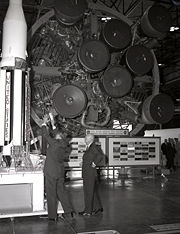
Interstate Highway System
One of Eisenhower's most enduring achievements was championing and signing the bill that authorized the Interstate Highway System in 1956. He justified the project through the Federal Aid Highway Act of 1956 as essential to American security during the Cold War. It was believed that large cities would be targets in a possible future war, and the highways were designed to evacuate them and allow the military to move in.
Eisenhower's goal to create improved highways was influenced by his involvement in the U.S. Army's 1919 Transcontinental Motor Convoy. He was assigned as an observer for the mission, which involved sending a convoy of U.S. Army vehicles coast to coast. His subsequent experience with German autobahns during World War II convinced him of the benefits of an Interstate Highway System. Noticing the improved ability to move logistics throughout the country, he thought an Interstate Highway System in the U.S. would not only be beneficial for military operations, but be the building block for continued economic growth.
Dynamic Conservatism
Throughout his presidency, Eisenhower preached a doctrine of dynamic conservatism.
He continued all the major New Deal programs still in operation, especially Social Security. He expanded its programs and rolled them into a new cabinet-level agency, the Department of Health, Education and Welfare, while extending benefits to an additional ten million workers. His cabinet, consisting of several corporate executives and one labor leader, was dubbed by one journalist, "Eight millionaires and a plumber."
Eisenhower was extremely popular, winning his second term in 1956 with 457 of 531 votes in the Electoral College, and 57.6% of the popular vote.
Eisenhower Doctrine
After the Suez Crisis, the United States became the protector of most Western interests in the Middle East. As a result, Eisenhower proclaimed the " Eisenhower Doctrine" in January 1957. In relation to the Middle East, the U.S. would be "prepared to use armed force...[to counter] aggression from any country controlled by international communism." On July 15, 1958, he sent just under 15,000 soldiers to Lebanon (a combined force of Army and Marine Corps) as part of Operation Blue Bat, a non-combat peace keeping mission to stabilize the pro-Western government. They left the following October.
In addition, Eisenhower explored the option of supporting the French colonial forces in Vietnam who were fighting an independence insurrection there. However, Chief of Staff Matthew Ridgway dissuaded the President from intervening by presenting a comprehensive estimate of the massive military deployment that would be necessary.
Civil Rights
Eisenhower supported the 1954 Brown v. Board of Education of Topeka U.S. Supreme Court decision, in which segregated (" separate but equal") schools were ruled to be unconstitutional. The very next day he told District of Columbia officials to make Washington a model for the rest of the country in integrating black and white public school children. He proposed to Congress the Civil Rights Acts of 1957 and 1960 and signed those acts into law. Although both Acts were weaker than subsequent civil rights legislation, they constituted the first significant civil rights acts since the 1870s. The " Little Rock Nine" incident of 1957 involved the refusal by Arkansas to honour a Federal court order to integrate the schools. Under Executive Order 10730, Eisenhower placed the Arkansas National Guard under Federal control and sent Army troops to escort nine black students into an all-white public school. The integration did not occur without violence. Eisenhower and Arkansas governor Orval Faubus engaged in tense arguments.
Supreme Court appointments
Eisenhower appointed the following Justices to the Supreme Court of the United States:
- Earl Warren, 1953 (Chief Justice)
- John Marshall Harlan II, 1954
- William J. Brennan, 1956
- Charles Evans Whittaker, 1957
- Potter Stewart, 1958
States admitted to the Union
Post-presidency
In 1961, Eisenhower became the first U.S. president to be "constitutionally forced" from office, having served the maximum two terms allowed by the 22nd Amendment to the U.S. Constitution. The amendment was ratified in 1951, during Harry S. Truman's term, but it stipulated that Truman would not be affected by the amendment.
Eisenhower was also the first outgoing President to come under the protection of the Former Presidents Act (two then living former Presidents, Herbert Hoover and Harry S. Truman, left office before Act was passed). Under the act, Eisenhower was entitled to receive a lifetime pension, state-provided staff and a Secret Service detail.
In the 1960 election to choose his successor, Eisenhower endorsed his own Vice President, Republican Richard Nixon against Democrat John F. Kennedy. However, he only campaigned for Nixon in the campaign's final days and even did Nixon some harm. When asked by reporters at the end of a televised press conference to list one of Nixon's policy ideas he had adopted, he replied, "If you give me a week, I might think of one." Kennedy's campaign used the quote in one of its campaign commercials. Nixon lost narrowly to Kennedy.
On January 17, 1961, Eisenhower gave his final televised Address to the Nation from the Oval Office. In his farewell speech to the nation, Eisenhower raised the issue of the Cold War and role of the U.S. armed forces. He described the Cold War saying: "We face a hostile ideology global in scope, atheistic in character, ruthless in purpose and insidious in method..." and warned about what he saw as unjustified government spending proposals and continued with a warning that "we must guard against the acquisition of unwarranted influence, whether sought or unsought, by the military-industrial complex... Only an alert and knowledgeable citizenry can compel the proper meshing of the huge industrial and military machinery of defense with our peaceful methods and goals, so that security and liberty may prosper together."
Because of legal issues related to holding a military rank while in a civilian office, Eisenhower resigned his permanent commission as General of the Army before entering the office of President of the United States. Upon completion of his Presidential term, his commission on the retired list was reactivated and Eisenhower again was commissioned a five-star general in the United States Army.
Retirement
Eisenhower retired to the place where he and Mamie had spent much of their post-war time, a working farm adjacent to the battlefield at Gettysburg, Pennsylvania. In 1967, the Eisenhowers donated the farm to the National Park Service and since 1980 it has been open to the public as the Eisenhower National Historic Site. In retirement, he did not completely retreat from political life; he spoke at the 1964 Republican National Convention and appeared with Barry Goldwater in a Republican campaign commercial from Gettysburg.
Death and funeral
Eisenhower died of congestive heart failure on March 28, 1969 at Walter Reed Army Hospital in Washington D.C. The following day his body was moved to the Washington National Cathedral's Bethlehem Chapel where he lay in repose for twenty-eight hours. On March 30, his body was brought by caisson to the United States Capitol where he lay in state in the Capitol Rotunda. On March 31, Eisenhower's body was returned to the National Cathedral where he was given an Episcopal funeral service. That evening, Eisenhower's body was placed onto a train en route to Abilene, Kansas. His body arrived on April 2, and was interred later that day in a small chapel on the grounds of the Eisenhower Presidential Library. Eisenhower is buried alongside his son Doud who died at age 3 in 1921, and his wife, Mamie, who died in 1979.
Legacy
After Eisenhower left office, his reputation declined and he was seen as having been a "do-nothing" President. This was partly because of the contrast between Eisenhower and his young activist successor, John F. Kennedy, but also because of his reluctance not only to support the civil rights movement to the degree that more liberal individuals would have preferred, but also to stop McCarthyism, even though he opposed McCarthy's tactics and claims. Such omissions were held against him during the liberal climate of the 1960s and 1970s. Since that time, however, Eisenhower's reputation has risen because of his non-partisan nature, his wartime leadership, his action in Arkansas and an increasing appreciation of how difficult it is today to maintain a prolonged peace. In recent surveys of historians, Eisenhower often is ranked in the top 10 among all US Presidents.
Tributes and memorials
Eisenhower's picture was on the dollar coin from 1971 to 1978. Nearly 700 million of the copper-nickel clad coins were minted for general circulation, and far smaller numbers of uncirculated and proof issues (in both copper-nickel and 40% silver varieties) were produced for collectors. He reappeared on a commemorative silver dollar issued in 1990, celebrating the 100th anniversary of his birth, which with a double image of him showed his two roles, as both a soldier and a statesman. As part of the Presidential $1 Coin Program, Eisenhower will be featured on a gold-colored dollar coin in the year 2015.
He is remembered for ending the Korean War. USS Dwight D. Eisenhower, the second Nimitz-class supercarrier, was named in his honour.
The Eisenhower Expressway (Interstate 290), a 30-mile (48 km) long expressway in the Chicago area, was renamed after him.
The British A4 class steam locomotive No. 4496 (renumbered 60008) Golden Shuttle was renamed Dwight D. Eisenhower in 1946. It is preserved at the National Railroad Museum in Green Bay, Wisconsin.
Eisenhower College was a small, liberal arts college chartered in Seneca Falls, New York in 1965, with classes beginning in 1968. Financial problems forced the school to fall under the management of the Rochester Institute of Technology in 1979. Its last class graduated in 1982.
The Eisenhower Medical Centre in Rancho Mirage, California was named after the President in 1971.
The Dwight D. Eisenhower Army Medical Centre, located at Fort Gordon near Augusta, Georgia, was named in his honour.
In February 1971, Dwight D. Eisenhower School of Freehold Township, New Jersey was officially opened.
The Eisenhower Tunnel was completed in 1979; it conveys westbound traffic on I-70 through the Continental Divide, 60 miles (97 km) west of Denver, Colorado.
In 1983, The Eisenhower Institute was founded in Washington, D.C., as a policy institute to advance Eisenhower's intellectual and leadership legacies.
In 1999, the United States Congress created the Dwight D. Eisenhower Memorial Commission, which is in the planning stages of creating an enduring national memorial in Washington, D.C., across the street from the National Air and Space Museum on the National Mall.
A county park in East Meadow, New York ( Long Island) is named in his honour. In addition, Eisenhower State Park on Lake Texoma near his birthplace of Denison is named in his honour; his actual birthplace is currently operated by the State of Texas as Eisenhower Birthplace State Historic Site.
Many public high schools and middle schools in the U.S. are named after Eisenhower.
There is a Mount Eisenhower in the Presidential Range of the White Mountains in New Hampshire.
A tree overhanging the 17th hole that always gave him trouble at Augusta National, where he was a member, is named in his honour.
The Eisenhower Golf Club at the United States Air Force Academy, a 36-hole facility featuring the Blue and Silver courses and which is ranked #1 among DoD courses, is named in Eisenhower's honour.
Awards and decorations
United States awards
In Order of Precedence
- Army Distinguished Service Medal with four oak leaf clusters
- Navy Distinguished Service Medal
- Legion of Merit
- Mexican Border Service Medal
- World War I Victory Medal
- American Defense Service Medal
- American Campaign Medal
- European-African-Middle Eastern Campaign Medal with one silver and four bronze service stars
- World War II Victory Medal
- Army of Occupation Medal with "Germany" clasp
- National Defense Service Medal (2 awards)
He was also an honorary member of the Boy Scouts of America's Tom Kita Chara Lodge #96.
International awards
List of citations bestowed by other countries.
- Argentinian Order of the Liberator San Martin, Great Cross
- Belgian Order of Léopold
- Belgian Croix de Guerre/Belgisch Oorlogskruis
- Brazil Campaign Medal
- Brazil War Medal
- Brazilian Order of Military Merit, Grand Cross
- Brazilian Order of Aeronautical Merit, Grand Cross
- Brazilian National Order of the Southern Cross
- British Order of the Bath, Knight Grand Cross
- British Order of Merit
- British Africa Star with "8" and "1" numerical devices.
- Chilean Chief Commander of the Order of Merit
- Chinese Order of Yun Hui, Grand Cordon
- Chinese Order of Yun Fei, Grand Cordon
- Czechoslovakian Order of the White Lion
- Czechoslovakian Golden Star of Victory
- Danish Order of the Elephant
- Ecuadorian Star of Abdon Calderon
- Egyptian Order of Ismal, Grand Cordon
- Ethiopian Order of Solomon
- French Croix de Guerre
- French Legion of Honour.
- French Order of Liberation
- French Military Medal
- Greek Order of George I with swords
- Guatemalan Cross of Military Merit, First Class
- Haitian Order of Honour and Merit, Grand Cross
- Italy Military Order of Italy, Knight Grand Cross
- Italy Order of Malta
- Luxembourg Medal of Merit
- Luxembourg War Cross
- Mexican Order of the Aztec Eagle, First Class
- Mexican Medal of Civic Merit
- Mexican Order of Military Merit
- Moroccan Order of Ouissam Alaouite
- Netherlands: Order of the Netherlands Lion, Knight Grand Cross
- Norwegian Order of St. Olav
- Pakistani Order of Pakistan, Nisham, First Class
- Panama Order of Vasco Nunez de Balboa, Grand Cross
- Panama Order of Manuel Amador Guerrero, Grand Master (collar grade)
- Philippines Distinguished Service Star
- Philippines Shield of Honour Medal, Chief Commander
- Philippines Order of Sikatuna, Raja (First Class)
- Polish Cross of Grunwald
- Polish Order of Polonia Restituta
- Polish Virtuti Militari
- Soviet Order of Suvorov
- Soviet Order of Victory
- Tunisian Order of Nichan Iftikhar, Gand Cordon
Other honours
- In 1966, Eisenhower was the second person to be awarded Civitan International's World Citizenship Award.
- Eisenhower's name was given to a variety of streets, avenues, etc., in cities around the world, including Paris, France.
- In December 1999, Eisenhower was listed on Gallup's List of Most Widely Admired People of the 20th Century.
